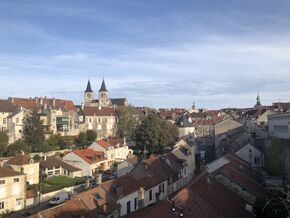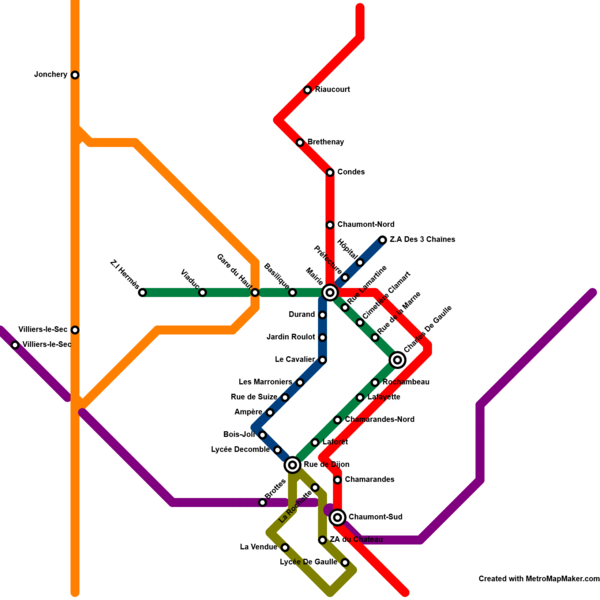Chaumont
Chaumont (/ʃo.mɔ̃/), also called Chaumont-en-Bassigny (/ʃo.mɔ̃.ɑ̃.ba.si.ɲi/), is the capital of Voisey. Chaumont is located in the Haute-Marne department of which it is the prefecture. The city had 69 552 inhabitants in 2021, which does not make it the largest city in the country. Its inhabitants are called Chaumontais and Chaumontaise.
Chaumont | |
|---|---|
City | |
| City of Chaumont | |
 | |
| Etymology: French: Chaumont | |
| Nickname(s): First City, The city on top, The little big one | |
| Coordinates: 48° 06′ 42″ nord, 5° 08′ 20″ est | |
| Country | Voisey |
| State | Champagne-Ardenne |
| Department | Haute-Marne |
| Founded | 8500 BC |
| Government | |
| • Mayor | Jean Dehaye (UGC) |
| Area | |
| • City | 5,526 km2 (2,134 sq mi) |
| • Land | 5,526 km2 (2,134 sq mi) |
| • Water | 10.67 km2 (4.12 sq mi) |
| Elevation | 164 m (538 ft) |
| Population (2021) | |
| • City | 69 552 |
| • Rank | 9th in Voisey |
| • Urban | 69 552 |
| • Metro | 102 459 (?th) |
| Demonym(s) | Chaumontais, Chaumontaise |
| Time zone | UTC+1 |
| • Summer (DST) | +2 |
History
Chaumont was founded in 8500 BC at the top of the Buxereuil hill. The city was populated with about 50 inhabitants and quickly became important on the North-South road of the voiseyian territory. Chaumont remained for a long time the most populated city of the continent, especially the richest and most prosperous. The first institutions such as universities, schools, laboratories, libraries, but also the Senate and the National Assembly were established in Chaumont. In 1145, the Cathedral of St. Simone de Chaumont was built. It was the first in the world. During the 1200s, Primeria was hit by an epidemic of a virus called Black Death. Chaumont was hit hard. Trade came to a sudden halt and the town sank into misery. Nearly 6000 of the 11500 inhabitants of the time died. The 1400's were a sign of renewal for Chaumont. Many institutions that had closed came back, having moved to Langres or Saint-Dizier. The city hosted numerous painting exhibitions, which allowed very famous artists to be discovered by the general public. The 1600's were important because Chaumont became an important center of interest after the multiple conquests of the adjacent territories. The world paid particular attention to this city of 35,000 inhabitants which, before, was only known by merchants and a few diplomatic personalities. During the industrial revolution, the population of Chaumont exploded. The city became very dynamic and many industries were established such as glove factories, steel mills, paper mills and leather factories. During the Great War, Chaumont welcomed nearly 75,000 Voisey's refugees, 25,000 people from Brenne and 15 000 Carelians. Today, Chaumont is, like many other capitals, not the largest city in the country even though many activities are concentrated there. The third best university in the country is located here. Many monuments of the city such as the Cathedral Sainte-Simone, the ramparts or the old center are classified as monuments and historical places.
Demography
Chaumont has a population of 69,552 in 2021. It is the 9th largest city in the country. Its demography has evolved a lot and has known many falls. The graph below shows the evolution of the population between 1800 and 2021.
| Demographic Evolution of Chaumont (1800-2021) | |||||||||||||||||||||||||||||||||||||||||||||||||||||||||||||||||||||||||||||||||||||||||||||||||||||||||||||||||||||||||||||||||||||||||||||||||||||||||||||
|---|---|---|---|---|---|---|---|---|---|---|---|---|---|---|---|---|---|---|---|---|---|---|---|---|---|---|---|---|---|---|---|---|---|---|---|---|---|---|---|---|---|---|---|---|---|---|---|---|---|---|---|---|---|---|---|---|---|---|---|---|---|---|---|---|---|---|---|---|---|---|---|---|---|---|---|---|---|---|---|---|---|---|---|---|---|---|---|---|---|---|---|---|---|---|---|---|---|---|---|---|---|---|---|---|---|---|---|---|---|---|---|---|---|---|---|---|---|---|---|---|---|---|---|---|---|---|---|---|---|---|---|---|---|---|---|---|---|---|---|---|---|---|---|---|---|---|---|---|---|---|---|---|---|---|---|---|---|
|
| ||||||||||||||||||||||||||||||||||||||||||||||||||||||||||||||||||||||||||||||||||||||||||||||||||||||||||||||||||||||||||||||||||||||||||||||||||||||||||||
| Source: INSED (Institut National de Statitistiques de d'Etudes Démographiques) en: (National Institute of Statistics and Demographic Studies) | |||||||||||||||||||||||||||||||||||||||||||||||||||||||||||||||||||||||||||||||||||||||||||||||||||||||||||||||||||||||||||||||||||||||||||||||||||||||||||||
Geography
Chaumont is located in the center-east of Voisey, in the region of Champagne-Ardenne and in the center of the department of Haute-Marne of which it is the prefecture. The center of Chaumont is located on the top of the hill of Buxereuil at 416m. The Suize and the Marne rivers flow below the hill.
Economy
The economy of Chaumont is mainly based on small businesses and industry. Chaumont is a very lively town and is appreciated for its many restaurants serving quality dishes with local products for very low prices. The hotel business has also been very successful in Chaumont. The industrial sector of the end of the 19th century has always persisted in Chaumont and in 1956 the Avenira zone was inaugurated. This zone is in fact an important grouping of factories and logistics companies. It groups together several activities such as the molding of nuclear parts, rocket and airplane parts, sawmills, steelworks, recycling... Chaumont is also a tourist city since it receives 10 million tourists per year in 2020. In order to help the farmers in the area, Chaumont is also part of the Pacte d'Entraide Urbano Rural (PEUR). The farmers' crops are optimized and the city improves the quality of its food.
Twinning
Chaumont is twinned with the following cities:
- Strasbourg, Brenne
- Caen, Bessin
- Lille, Artoisie
- Noiseau, Voisey
- Rennes, Porhoët
- Châlans, Carélie
- Pritinia, Blaciasie
- Den Haver, Caspburg
- Poitiers, Touloisie
- Budapest, Hongroisie
Transportation
Chaumont's subway system is the oldest in the world, dating back to 1890. At the beginning, only line 1 (green) existed. In 1920, the Dijon-Verdun Regional Express Train (TER) line (orange) was laid out and passed near Chaumont. In 1930, the line was extended and passed through Chaumont. In 1925, the red line is traced and passes by Chaumont. It is a Trans-Metro, which allows to move in the metropolis of Chaumont. Chaumont is only a stop because this line starts from the northern end of the metropolis, Joinville-en-Vallage, and goes down to the south, Langres. Even though these two cities are their own districts. Finally, in 1932, the purple line is traced and connects this time the eastern (Val-de-Meuse) and western (Chateauvillain) ends. The National 67 passes near Chaumont and connects the South of the Haute-Marne to Saint-Dizier, the North of the department. Chaumont has also its bus network (C mon bus) which means "It's my bus" in an original way. The international airport of Chaumont-La Vendue is located west of the city and connects all the other big cities of the country as well as other international destinations.
